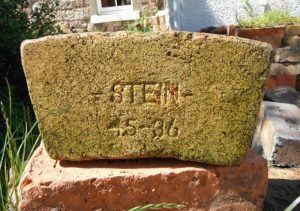(Note – SBH – I am uncertain as to where, over the years, they exactly mined their fireclay. I have added some references here with regards to clay mines but it is difficult when researching the newspaper archives to distinguish between this company and the closely located Steins Castlecary Works).
Castlecary Fireclay Company Limited, Castlecary, Cumbernauld.
See also the “Scottish Fire Brick Company“.
1875 – William Logan and Co, Castlecary Fireclay Works, Cumbernauld.
1878 – W and J Logan, brick and tile manufacturer, Castlecary.
1880 – Invoices x 8 – William Logan and Co, Castlecary Fireclay Works near Glasgow. Manufacturers of fire bricks for high heats, furnace blocks &c.
22/01/1883 – Daily Gazette for Middlesbrough – A new industry for Middlesbrough. Today (Monday) the Middlesbrough Fire Brick Company commenced operations at their new works in the Marshes, Middlesbrough. Fire bricks have always been an important factor in the iron and steel trade. Until within the last five years, the cheap fire bricks from the Durham coal fields were almost invariably used in the Cleveland district for the linings of blast furnaces, cupolas for puddling and mill furnaces, and in other places where great heat was to be withstood. For some time past, however, the Durham bricks have been gradually displaced by the higher class bricks from the Leeds district, from Stourbridge, and from Scotland for all important positions as a fire resister. The Scotch bricks are used at the Steel Works at South Bank, and other firms in the district distribute their orders for thin best bricks principally between the Leeds and Scotch makers. The Durham and Newcastle bricks are now but little used, except for parts least exposed to great heat. The great advantage and economy of using the best bricks is easily understood when we compare their duration, say, in an ordinary puddling furnace. An ordinary Durham fire brick will only last from three to four weeks, whilst the best Leeds and Scotch vary from nine to eleven weeks in a corresponding position. The cost of material and labour in rebuilding the furnace, the loss of time, and the continuous patching up amount to a serious item, and have caused ironmasters to be very careful in the quality of the brick they use. The Middlesbrough Fire Brick Company’s new works are situated between the Linthorpe Iron Works and Ayrton Rolling Mills and stand upon about an acre of ground. On the south side, they are connected with the North-Eastern Railway. They are also attached to the Middlesbrough Owners’ private lines to the ironworks and wharves on the river between Newport and Linthorpe Ironworks. The works consist of a large gantry for stocking their raw material (capable of holding 2,000 to 3,000 tons of clay &c), engine-house, millhouse, with large edge running stones, a pug mill, a mixing pan, elevators, &c. The drying shed is a substantial brick building capable of drying about 100,000 ordinary bricks per week. The three burning kilns are of the cone shape, and have been built by the celebrated kiln builder, Mr Robertson, of Glasgow, and are specially arranged to burn the bricks at an intense heat. There are three lines of rails inside the works to the gantry, mill house and kilns. Arrangements are also made for enlarging the works should it be deemed advisable. There is little of an experimental character about the undertaking. The managing partner of the Castlecary Fire Clay Company (of Scotland) is a director of the Company and one of the largest shareholders for some time past. Bricks made from the clay which the new Company are using have been used in considerable quantities in Middlesbrough, and are well known. In addition to the Scotch fire brick, the firm also intends producing ganister fire bricks and ganister prepared for use in the Bessemer converters. For some time past this latter material, which is largely used in steel works, has come from Sheffield, but the new firm has been experimenting with the local ganister, and are, we understand, producing an article equal in quality and identical in analysis to the best Sheffield ganister.
27/10/1883 – Paisley & Renfrewshire Gazette – Scotch bankrupts – William Logan, fire clay manufacturer, Castlecary Fireclay Works and residing at Gladstone Cottage, Lenzie wither as William Logan or trading as William Logan and Co, Castlecary, Cumbernauld or as the Castlecary Fireclay Company, Castlecary near Glasgow.
22/02/1884 – Glasgow Herald – Upset price reduced to £2500. To be sold by public roup, within the counting-house of Moore and Brown CA, 128 Hope Street, Glasgow on Tuesday 9th March 1884 at two o’clock afternoon. The stock in trade, plant, machinery &c belonging to the sequestrated estate of William Logan (Trading as Castlecary Fireclay Co) with the goodwill of the business and the trustee’s interest in the lease of the clay field as formerly advertised. An inventory of the stock, plant &c can be seen and former information had on application …
Below – 06/08/1884 – Castlecary Fireclay Company – Court action Wm Dixon Limited, Ironmongers sued Hugh Martin Senior, Coatbridge and others including William Logan for £108 6s for unpaid coal.


18/07/1885 – Glasgow Herald – Mary Ann Bryan or Martin V John William Burns. In this section John Wm Burns of Kilmahew and Cumbernauld sought to hold the widow and executrix of the late Hugh Martin Snr, ironmaster, Coatbridge, liable to £200 as the full years rent said to be due under a lease held by her husband of certain fireclay seams on the pursuers lands. For the defender, it was maintained that on a right interpretation of the lease the deceased’s tenancy of the fireclay field ceased on his death and that no liability for rent after that event attached to the defender.
The Lord Ordinary Trayner, in deciding the case said the original lessees were Mr Wm Logan and Mr Hugh Martin, SNR, and the death of the latter had left Mr Logan the sole tenant under the lease. In ordinary circumstances the liability for the rent would follow the right the privileges conferred but in this case the pursuer maintained that the defender was liable for the rent sued for, and the whole rent due under the lease in respect of its special terms, one clause providing that the lessees bound themselves and their respective heirs and successors conjunctly and severally to pay to Mr Burns the sum of £200 yearly under the lease. His Lordship accordingly pronounced decree for the sum sued for with expenses.
The defender appealed to the Second Division, and their Lordships today, Lord Rutherford – Clark dissenting, reversed the decision of the Lord Ordinary and found expenses due to the defender on the ground that the clause did not bind the executors of the predeceasing tenant. (Note – SBH – Could the fireclay seams referred to be those worked by the Castlecary Fireclay Company Limited)
15/12/1886 – Falkirk Herald – The Castlecary Fireclay Co beg to inform farmers that they have re-opened the working of limestone at Castlecary and can now supply lime shells.
1886 – Middlesboro Fire Brick Company Limited, Castlecary, Cumbernauld.
05/06/1889 – Falkirk Herald – On Thursday forenoon, while a man named David Forfar was engaged in digging clay in the works of the Castlecary Clay Company, near Cumbernauld, a large quantity of soil fell on him. He was at once conveyed to the Royal Infirmary, Glasgow, in an ambulance waggon. It was found necessary to amputate the left leg. He has also received a severe scalp wound.
Below – 1890 – Castlecary Fireclay Works 2 Exchange place, Middlesbrough; Joseph McLauchlan, agent.

28/09/1894 – Edinburgh Gazette – William Logan, formerly designed as William Logan, Fire-Clay Brick Manufacturer, Castlecary Fire-Clay Brick Works, Castlecary, and residing at Gladstone Cottage, Lenzie, either as William Logan, or as trading as William Logan & Company, Castlecary, Cumbernauld, or as the Castlecary Fire Clay Company, Castlecary, near Glasgow, he being the only Partner therein, and now residing at 81 Wakefield Road, Stalybridge, has presented a Petition to the Sheriff of the Counties of Stirling, Dumbarton, and Clackmannan at Dumbarton, craving to be discharged of all debts and obligations contracted or owing by him or for which he was liable at the date of Sequestration of his Estates (19th October 1883); of which Intimation is hereby given, in terms of the Bankruptcy Statutes and the Deliverance of Mr Sheriff Gebbie, of date 24th September current, upon said Petition. McLure, Naismith, Brodie and Company, Agents for Petitioner. Glasgow, 26th September 1894.
23/1/1895 – Northern Echo – Middlesbrough trades and arts exhibition … Joseph McLauchlan, Exchange Place, Middlesbrough. Stand no 74. Castlecary fire clay bricks for use in steel, iron and gas works &c. Coldknott Silica Brickworks, coke ovens and fire brick works. Etherley Grange Colliery House, steam and gas coals, building bricks, draining pipes &c.
Below – 1896 – Advert Castlecary Fireclay Works.
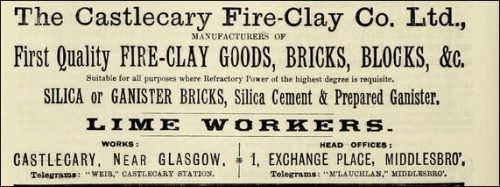
Below – 1896 – Castlecary Fireclay and Lime Works.

05/06/1897 – Daily Gazette for Middlesbrough – The Brussels exhibition … Joseph McLauchlan. Mr McLauchlan owns the Cold Knott Silica Brick Works situated at Crook in the County of Durham. The bricks from these works are very largely used in the steelworks of the Cleveland district. Large quantities are exported from Middlesbrough, West Hartlepool and Newcastle on Tyne, the works being favourably situated for an export trade to the continent of Europe. The raw ganister stone is obtained from the Pennine range of hills near the works. The quantity of silica bricks made at the works is about 2,500,00 per annum. There is also a considerable production of blocks, pugged ganister and ganister cement. Exhibits:- Cold Knott silica bricks for use in Siemens and copper smelting furnaces, gas works, coke ovens and processes generally involving intense and long-continued heat. The raw material used in manufacture. Samples of Durham foundry coke. Mr McLauchlan also exhibits articles from the Castlecary Fireclay Works, Castlecary, Glasgow. The works are connected with the North British Railway on the mainline between Edinburgh and Glasgow and are 15 miles from Glasgow and 8 miles from Grangemouth. Extensive shipments from the works are made at Glasgow to India, Canada and the principal continental ports. Large quantities of clay and bricks are shipped at Grangemouth for Germany, Belgium, Russia etc. The quantity of bricks made at the works is about 2,500,00 per annum of blocks, 2,000 tons; manufactured clay 2,500 tons. The raw clay produced is about 20,000 tons annually and limestone produced is about 10,000 tons, the latter being manufactured into building lime. High-class fire clay goods such as are extensively used in steel and ironworks, chemical, glass, copper and gas works, in coke ovens and all descriptions of furnaces of processes requiring excessive heat or involving sudden changes of temperature. Samples of raw material used in manufacture.
08/10/1898 – Northern Weekly Gazette – Middlesbrough trades and arts exhibition … Mr J. McLauchlan of Exchange Place displays specimens of Scotch fire bricks and blocks from the Castlecary Works, to be used where there is intense heat and where sudden changes in temperature have to be encountered …
05/10/1901 – Kilsyth Chronicle – New justices of the peace for Dumbartonshire … Alexander Weir, fire clay manufacturer, Castlecary House, Cumbernauld …
15/07/1904 – Kilsyth Chronicle – The fireclay works report brisk trade, Messrs Weir, Castlecary, having this week despatched a large shipping order per canal.
1906 – Invoice x 2 – Castlecary Fireclay and Lime Works, Castlecary near Glasgow.
30/09/1908 – Daily Gazette for Middlesbrough – Joseph McLauchlan Limited, Midland Bank Chambers, Middlesbrough. High-class fire bricks, Castlecary (Scotch) magnasite and silica. House, steam, gas and coking coals. Steamers’ bunkers. Foundry and furnace coke.
1909 – Castlecary Fireclay Co Ltd established.
Below – 11/02/1910 – Kirkintilloch Gazette – Weirs Castlecary Fireclay Co Ltd in Court action with a firm from Canada over an alleged Agency agreement to sell Castlecary bricks in Canada.
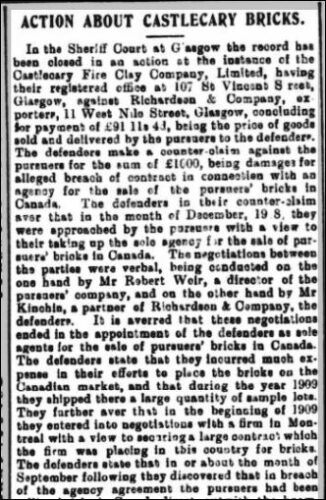

09/03/1912 – Falkirk Herald – The firm of Messrs J. G Stein Co Ltd, Bonnybridge and Castlecary Brick and Fireclay Works and the Messrs Dougall and Co, Bonnyside Fireclay Works closed their works on Saturday last due to the restrictions and scarcity of coal. Up to 700 hands are affected by the stoppage.
17/08/1912 – Falkirk Herald – Presentation. Mr Robert Weir, manager at Castlecary Brickworks, prior his departure for Alabama, was waited upon at his residence by a deputation of the workers, who presented both him and his wife with a dressing case as a token of remembrance to carry with them across the sea.
Below – 1913 – Castlecary Fireclay and Lime Works.

13/08/1913 – Dundee Evening Telegraph – The long spell of dry weather is now having a serious effect on the industries in Eastern Dumbartonshire. Owing to the shortage of water the miners and moulders employed by the Glenboig Union Fireclay Company at their Cumbernauld Works have had to stop work for the present. At Messrs Weir’s Fireclay Works at Castlecary the situation has also become so serious that the workmen are being thrown idle. Some hundreds of workmen are affected.
07/08/1914 – Kirkintilloch Gazette – Castlecary. Messrs Weir’s fireclay workers were paid off on Monday owing to the present crisis. It is likely that other works in the district will have to close down also unless the prospects of peace get brighter.
04/04/1919 – Kirkintilloch Gazette – Castlecary. The brick workers have begun a 47 hours week. Messrs Weir gave them a free choice of how they would arrange the week, and the workers decided to do the 47 hours on the five days and keep the Saturday as an idle day.
05/09/1919 – Kilsyth Chronicle – New Companies registered last week – Castlecary Fireclay Company (Limited). Capital £100,00 in £1 shares. To acquire and carry on the existing undertaking. Subscribers John J McMurdo, Solicitor, Airdrie, John Weir, Brick Manufacturer, Castlecary; James Winning, C.A, Glasgow; Robert Dunlop, Brick Manufacturer, 45 Renfield Street, Glasgow; Andrew Weir, Brick Manufacturer, Castlecary; J.N. MacMurdo, Brick Manufacturer, Airdrie, J.C.McGregor, Solicitor, Airdrie.
05/09/1919 – Kilsyth Chronicle – New Companies registered last week – Faskine and Palacecraig Brick and Coal (Limited). Capital £10,000 in £1 shares. Private Company. Subscribers John J McMurdo, solicitor, 10 Bank Street, Airdrie, and John Weir, brick manufacturer, Castlecary by Bonnybridge.
1920 – 21 – Castlecary Fireclay Co., Ltd., firebrick furnace block manufacturers, Castlecary, Palacecraig Colliery and Faskine Brickworks, Airdrie. Office, 45 Renfield street. Tel. Nos, 3406 Central and 12 Dullatur; telegrams, “ Weir, Castlecary, Glasgow.”
13/05/1921 – Kirkintilloch Gazette – Housing – Kirkintilloch – The Castlecary Fireclay Company Limited has reported that they are not in a position to offer bricks from the Faskine Works, Airdrie. The housing committee is to inspect houses built with concrete at Wardie, Edinburgh.
26/08/1921 – Kirkintilloch Gazette – Fireclay workers are beginning to feel the effects of dullness in trade. On Wednesday workers had an idle day.
Below – 10/02/1922 – Kirkintilloch Gazette – Court action Weir Castlecary Fire Clay Co Ltd V ex-works manager Robert Stewart.




15/11/1922 – Robert Weir, Bowhill appointed manager at Castlecary Brick and Fireclay Works belonging to Messrs Stein and Co. Mr Weir was under manager at Kinglassie Colliery previous to his appointment at Bowhill.
08/09/1923 – Falkirk Herald – Short time – The workers employed at the Castlecary Fireclay Company Works are, owing to a scarcity of orders, at present on short time. For some time past the miners have been working 5 days a week and now the above-ground employees are only receiving 4 and 5 days work per week.
20/02/1926 – Falkirk Herald – Trade slackness. Through slackness in trade at the present time the workmen employed at Weir’s, Castlecary pit and works are short time. They were idle Thursday, and it is expected that four days a week will be the rule, for a period.
19/09/1928 – Falkirk Herald – Castlecary carter is convicted at Falkirk Sheriff Court. David Purdie, carter, Cottage, Seabegs Road, Castlecary, appeared before Sheriff Robertson at Falkirk Sheriff Court, on Monday, charged with having, on 18th August, at Castlecary Brickworks, Castlecary, cruelly ill-treated a light brown mare by causing it to work while it was suffering from a raw sore under the saddle … Found guilty after a trial and fine £1.
17/01/1936 – Kirkintilloch Gazette – Messrs Weir & Co, Castlecary Fireclay Works, on Friday night entertained their employees to a supper and dance in Castlecary Hall where a company of 170 partook of an excellent repast presided over by Mr J Weir, and then tripped it joyously for some hours to the strains of the Metronome Band with Mr W Bremner supervising the proceedings.
26/10/1936 – Sheffield Independent – Capital of another Scottish Company bought for cash. General Refractories Ltd., of Sheffield, has purchased for cash 98.50% of the share capital of the Castlecary Firebrick Company, Castlecary, Scotland. The latter was formed in 1909 and has an issued capital of £50,000. It is well equipped for the large scale production of the highest class of Scottish firebrick and is possessed of unusually large reserves of fireclay. For many years it has been able to export considerable quantities of fireclay, in addition to supplying manufacturers at home.
24/07/1937 – Falkirk Herald – Fair holidays – The district of Longcroft, Haggs, and Banknock have been on holiday this week in conjunction with the Glasgow Fair. On Friday Messrs Dobbie’s Foundry closed down for a week, while Castlecary and Cannerton Brickworks closed for only two days, the brickmaking industry at this time being exceptionally busy. Naturally, with such a short holiday, the majority stayed at home but took full advantage of the many and varied day excursions by train and bus. On Wednesday, both Castlecary and Cannerton Brickworks made a full start at the usual hour.
17/12/1937 – Kirkintilloch Gazette – Railway disaster at Castlecary. 35 dead … Messrs Weir, Castlecary Fireclay Works, did much-appreciated work in fitting temporary electric lights so that the rescue work could proceed. It was a very thoughtful action
1938 – Castlecary Fireclay Company Limited, Castlecary Station, Bonnybridge, Stirlingshire; mine name – Castlecary – fireclay; Situation – Castlecary Station; Manager – Hugh McPhail; 23 employees below ground and 8 above.
Below – 12/10/1938 – Many thanks to Gabi Chadwick for sending these photos. This drinks cabinet was found in a charity shop in Stockport, England. The brass plaque in inscribed thus ” Presented by the employees of the Castlecary Fireclay Co Ltd to Mr and Mrs John Weir on the occasion of their marriage. 12/10/1938.

.

06/01/1939 – Western Mail – General Refractories scheme of consolidation … In accordance with the policy of consolidation which is now in progress the board of the General Refractories Ltd announces that certain subsidiary companies are being placed into voluntary liquidation for the purposes of amalgamation … In addition, the following companies are being liquidated for the purpose of amalgamation with the Glenboig Union Fireclay Company Ltd:-Castlecary Firebrick Company, Ltd., Faskine and Palacecraig Bricks and Coal, Ltd., and George Turnbull and Co., Ltd …
Below – 1946 – Castlecary Fireclay and Lime Works.
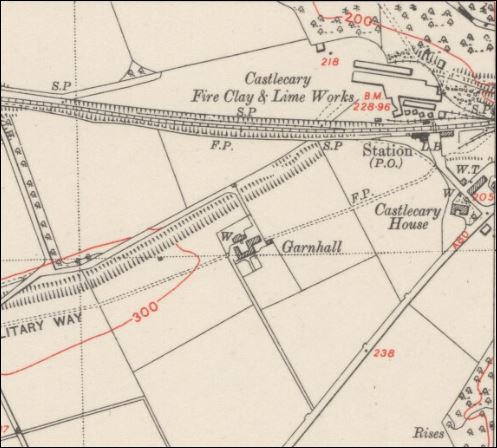
Below – 02/1962 – Refractories Journal – An advert for Glenboig bricks including the stamps ‘Glenboig A 1’, ‘Glenboig’, ‘GEM’ and ‘Castlecary. In 1936 General Refractories took over the Castlecary Fireclay Co Limited and the company became part of the Glenboig Union Fireclay Company. It appears that the GUFC continued the CFCL brands that were ‘GEM’ and ‘Castlecary’.
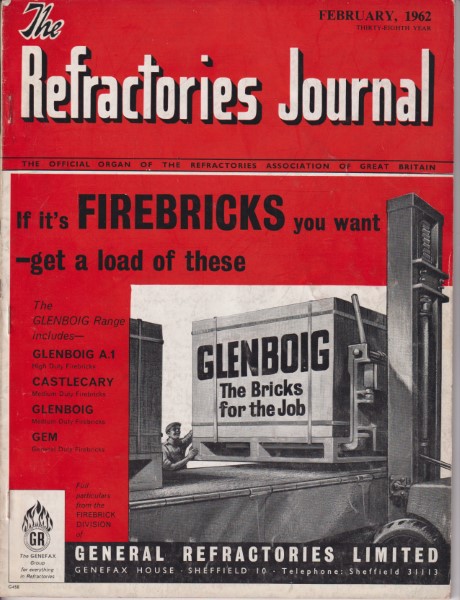
Below – c.1967 – Weir’s Castlecary Brickworks.
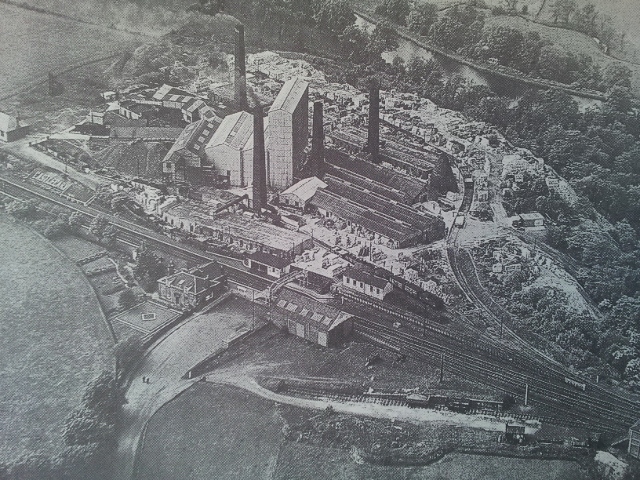
c. 1968 – The works closed.
******************************************

The Castlecary limestone formations are well known geologically, and it was to work these as much as the fireclays that Alexander Weir built the Castlecary Fireclay and Lime Works which by 1898 had 5 beehive kilns for firebricks and 3 shafts for limestone.

Castlecary Fireclay Company Limited – Established during the late 19th century by Alexander Weir and incorporated in 1909. Works in Castlecary known as Weir’s Castlecary in order to distinguish from Stein’s Castlecary Works which were nearby. Acquired Faskine & Palacecraig Brick & Coal Co in 1918. Taken over by General Refractories of Sheffield in 1936 and became part of the Glenboig Union Fireclay Co. Works closed in 1968
The Lugar ironworks worked up until 1928 and had 5 blast furnaces. They were dismantled in 1938 when it was noticed that the hot- blast stoves were filled with Weirs Castlecary brand firebricks
Site names – Castlecary Fireclay and Lime Works.
Address -Alexander Weir Castlecary House and Exchange Place, Middlesbrough.
Source – Falkirk Archives.
*******************************************************
The Castlecary Fireclay Company Limited was incorporated in 1909, with a capital of £22,000. Alexander Weir and his son Robert held the controlling interest, but George Chisholm, an iron merchant of Glasgow, and John Maxwell, a solicitor from Falkirk, were also directors. The profit record has survived, but it’s most disappointing with the preference dividend only being paid in the first year. Alexander Weir died in 1917, and as soon as the war was over, the company was reconstructed under the Chairmanship of John McMurdo who became the principal shareholder. At this time too, the Company bought the Faskine and Palacecraig Brick and Coal Company with collieries on the North bank of the Monkland Canal. The Faskine Brickworks was re-equipped with new machinery and could produce 16, 000 bricks a day, but it was the coal that made the profits. Andrew Weir resigned as Director and Company Secretary in 1920, as his health had been undermined by his war service in France, but his brother, Robert, continued as Managing Director. A second Belgian kiln was built at Castlecary and machinery was installed to make 35, 000 bricks a day. The Company was making some profits now, but the Income Tax Inspector was claiming £4,000 in excess profits duty. Today with our stricter financial control, it is amusing to read in the Director’s minutes that the Company Secretary was instructed to tell him that no money was available to pay such a sum as all production was going into stock and that there were few sales for cash. Stocks had risen to £15,000 and with capital expenditure on the plant, the preference dividend had been passed. Clearly, the Tax Inspector had to wait his turn.
Profits slumped in 1922 and 1923 partly due to the coal strike which left the Company with only 1 week’s supply at the kilns. At this critical time the works manager, John Weir and his family contracted scarlet fever and diptheria, a reminder of the uncertainty of life before the days of modern medicines.
There was one windfall in 1925 when the Company received £10,000 for their claims against the London & North-Eastern Railway for the fireclay they had to leave unmined under the Castlecary Viaduct. The claim had been brought under the Mines ( Working Facilities and Support) Act 1923 and while £600 went to the Carron Company for their Hirst Coal, and another £2,400 to the mineral landlord, the remaining £7,000 was most welcome.
The mining of limestone ceased after the 1914 – 1918 war, and the shaft kilns were demolished. In their place, a third and larger Belgian kiln was built with 19 chambers, compared with the 12 and 14 chambered kilns already working. Castlecary now concentrated on firebricks for the iron and steel industry. Castlecary was the main brand in the 35/37% alumina range, and Weir Brand was used for the lower 27/30% alumina grade up to 1932 when the GEM brand replaced it. The Weir brand was then used for a new 42/43% alumina brick.
Exports of fireclay and firebricks became big business from 1927 onwards, particularly to Italy. Payments were not received promptly and the Company was owed £4,000 at one time. Discussions took place and the Italian Company offered them a holding in their Genoa works to be paid for by a reduction in the price of fireclay from 15/-d (75p) to 10/-d (50p) per tonne on the next 10,000 tons. It was an ill-conceived agreement as the Castlecary Fireclay Company could not afford the reduction in the cash flow for a shareholding unlikely to pay a dividend. A large £14,787 order was received from Russia in 1927, but again cash flow suffered as only 30% was paid on shipment and the balance had to wait 18 months for payment. It was not surprising that the bank overdraft rose to £12,000 and now the inland revenue was demanding immediate payment of income tax, corporation tax and excess profits duty.
The post-war depression was now biting hard and by May 1932 only 1 kiln was working and that at the slowest possible schedule. The directors took a 25% salary cut, while staff and employees suffered similar cuts. All dividends were passed. These hard times continued and it must have been with considerable relief that the Chairman received an offer for the Company from General Refractories of Sheffield. The offer was accepted in 1936, and the Company became part of the Glenboig Union Fireclay Company, their Scottish subsidiary.
The Castlecary Fireclay Works continued in production in the post-war years when it was known as Weirs Castlecary to distinguish it from Steins Castlecary Works across the road. Production was about 2,200 tons a month with 170 men and workmen employed. In addition, there were 32 miners. The Works were closed in 1968 when most employees were offered work at Steins Castlecary Works. The site was cleared in the 1970s. Source The Scottish Refractory Industry 1830 – 1980
Below – Castlecary firebrick analysis.

Some advertising from a Castlecary catalogue … Castlecary fire bricks are acknowledged to be of the finest quality for furnace building.
When high and long sustained heat and sudden changes of temperature have to be contended with, Castlecary bricks are unsurpassed. They are capable of withstanding very high temperatures without melting or splitting and practically without expansion or contraction.
The thermal stability of Castlecary fire bricks corresponds to 36 Seger cone – 1700 degrees C or 3254 degrees F.
Castlecary fire bricks are extensively used in Ladle Lining (basic and acid), Regenerators, heating, soaking, mill, puddling and forge furnaces. We specialise in blast furnace block, Ford and Moncur and Cowper hot blast stove bricks.
In rapid steaming boiler arches where heats are extreme, either from stoker firing or oil firing, the very best results have been obtained with Castlecary material.
Glassworks, gas works and chemical works will find Castlecary fire clay blocks and special fire bricks admirably suited for their temperatures.
Oil fuel furnaces built with Castlecary fire bricks have given wonderful results in both land and marine furnaces and locomotive arches.
Electric furnaces constructed with our special Castlecary Alumina bricks have given excellent results. A long life has been obtained in these furnaces carrying very high heats. We can with all confidence recommend them for this purpose. They are high in alumina, evenly balanced with silica and exceptionally free from iron or other fluxing material.
In laying first quality fire bricks it is most important to use first quality fire clay. If the clay is inferior in quality to the bricks it will melt and run long before the bricks are affected and leave an open joint where flames and slag can most easily attack the lining.
Use first quality fire clay – use as little as possible by laying the bricks skin to skin.
We invite you to fully investigate the possibilities of Castlecary and Castlecary Alumina fire bricks for the economical running of your furnaces.
*********************************
CASTLECARY – Castlecary Fireclay Co. Ltd (c1919) – furnace lining brick manufactured by the Castlecary Fire clay Company under the ownership of Alderman MacLauchlan of Middlesbrough. A good variety of bricks were imported or shipped into California. In the early days, foreign bricks were brought to California as ship ballasts. These were dumped on the shore, and the boats refilled with California wheat for the return trip home.
******************************




























